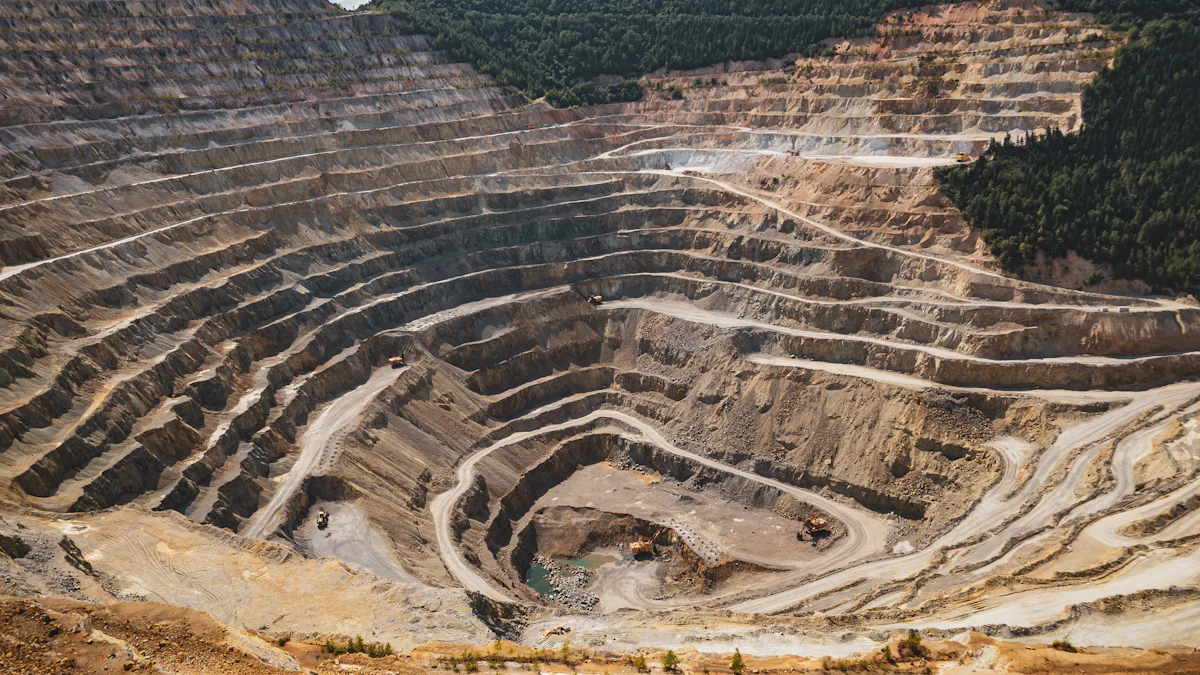
SiC coated graphite carriers deliver exceptional performance in demanding industrial environments. Their durability ensures reliable operation under extreme conditions, while their superior thermal conductivity enhances efficiency in high-temperature applications. These carriers resist wear, corrosion, and oxidation, making them ideal for industries like semiconductor manufacturing and renewable energy. The long lifespan of these carriers reduces replacement frequency, and their minimal maintenance needs lower operational costs. By combining advanced materials with cutting-edge technology, SiC coated graphite carriers provide a cost-effective solution for industries seeking to optimize productivity and reduce expenses.
Key Takeaways
- SiC coated graphite carriers offer exceptional durability and thermal conductivity, making them ideal for high-temperature industrial applications.
- The silicon carbide coating enhances resistance to wear, corrosion, and oxidation, significantly extending the lifespan of the carriers.
- Industries can reduce operational costs through lower maintenance needs and minimized downtime, thanks to the robust performance of these carriers.
- Integrating SiC coated graphite carriers into operations leads to improved energy efficiency, optimizing heat transfer and reducing energy consumption.
These carriers are particularly beneficial in semiconductor manufacturing, aerospace, automotive, and energy production, where precision and reliability are crucial.
Compared to uncoated graphite and metal carriers, SiC coated graphite carriers provide superior performance, making them a more cost-effective choice. - Adopting SiC coated graphite carriers aligns with sustainability goals, as their longevity and efficiency contribute to reduced environmental impact.
Material Properties of SiC Coated Graphite Carriers

Graphite's Contribution to Performance
Graphite serves as the foundation for SiC coated graphite carriers, offering exceptional thermal and mechanical properties. Its high thermal conductivity ensures efficient heat transfer, which is critical in high-temperature industrial processes. The material's lightweight nature reduces the overall weight of the carrier, making it easier to handle and transport. Additionally, graphite exhibits excellent machinability, allowing manufacturers to create precise designs tailored to specific applications. These characteristics make graphite an indispensable component in achieving optimal performance in demanding environments.
Advantages of Silicon Carbide Coating
The silicon carbide (SiC) coating enhances the functionality of graphite carriers by providing superior chemical and mechanical stability. This coating offers remarkable resistance to oxidation, corrosion, and thermal shock, ensuring reliable performance even in aggressive environments. SiC's high hardness and wear resistance protect the underlying graphite from damage, extending the carrier's lifespan. Furthermore, the coating's dense surface structure prevents the penetration of harmful substances, maintaining the carrier's integrity over time. These advantages make SiC coatings a vital addition to graphite carriers, enabling them to withstand the challenges of modern industrial applications.
Combined Benefits of SiC Coated Graphite Carriers
The combination of graphite and silicon carbide creates a carrier that excels in both durability and efficiency. The graphite substrate provides a lightweight and thermally conductive base, while the SiC coating adds strength and resistance to external factors. Together, these materials ensure consistent performance in high-temperature and chemically aggressive environments. SiC coated graphite carriers also minimize the risk of failure during operation, reducing downtime and maintenance costs. Their ability to maintain structural integrity under extreme conditions makes them a reliable and cost-effective solution for industries such as semiconductor manufacturing and energy production.
Cost-Effectiveness Factors
Longevity and Durability
SiC coated graphite carriers demonstrate exceptional longevity due to their robust material composition. The silicon carbide coating provides a protective layer that resists wear, oxidation, and chemical corrosion. This durability ensures the carriers maintain their structural integrity even in harsh industrial environments. Unlike conventional graphite carriers, which may degrade over time, these carriers retain their performance capabilities for extended periods. The combination of high-purity isostatic graphite and a thin SiC coating enhances their lifespan, reducing the need for frequent replacements. Industries benefit from this extended service life by significantly lowering material procurement costs.
Reduced Downtime and Maintenance
The superior durability of SiC coated graphite carriers directly contributes to reduced downtime and maintenance. Their resistance to damage minimizes the likelihood of operational interruptions caused by carrier failure. For instance, in semiconductor manufacturing, where precision and consistency are critical, these carriers ensure uninterrupted production cycles. The silicon carbide coating prevents the accumulation of contaminants and protects against thermal shock, reducing the frequency of cleaning and repairs. By requiring less maintenance, industries can allocate resources more efficiently, improving overall productivity and cost management.
Energy Efficiency
SiC coated graphite carriers excel in energy efficiency due to their excellent thermal conductivity. The graphite substrate facilitates rapid heat transfer, while the silicon carbide coating ensures consistent thermal performance. This combination optimizes energy usage in high-temperature processes, such as those found in semiconductor and energy production industries. Efficient heat dispersion reduces energy consumption, leading to lower operational costs. Additionally, the carriers' ability to maintain stable temperatures enhances process reliability, further contributing to energy savings. By integrating these carriers into their operations, industries can achieve both environmental sustainability and financial benefits.
Comparison with Alternative Materials
SiC Coated Graphite vs. Uncoated Graphite
SiC coated graphite carriers outperform uncoated graphite in several critical areas. The silicon carbide coating provides a protective barrier that enhances resistance to oxidation, corrosion, and thermal shock. Uncoated graphite, while offering excellent thermal conductivity, lacks the durability required for high-temperature and chemically aggressive environments. The SiC coating also reduces surface roughness and porosity, which minimizes contamination risks during industrial processes. This feature is particularly valuable in semiconductor manufacturing, where precision and cleanliness are paramount. By combining the strengths of graphite with the added protection of SiC, these carriers deliver superior performance and longevity compared to their uncoated counterparts.
SiC Coated Graphite vs. Metal Carriers
Metal carriers, though robust, fall short in applications requiring high thermal conductivity and chemical resistance. SiC coated graphite carriers excel in these areas, offering better heat transfer and stability under extreme conditions. Metals are prone to oxidation and corrosion, especially in high-temperature environments, which can lead to frequent replacements and increased maintenance costs. In contrast, the SiC coating shields the graphite substrate from chemical and thermal damage, ensuring consistent performance over time. Additionally, the lightweight nature of graphite reduces the overall weight of the carrier, making it easier to handle and transport compared to heavier metal alternatives. These advantages make SiC coated graphite carriers a more efficient and cost-effective choice for demanding industrial applications.
SiC Coated Graphite vs. Ceramic Carriers
Ceramic carriers provide excellent thermal stability and resistance to high temperatures, but they often lack the mechanical flexibility and durability of SiC coated graphite carriers. Ceramics are brittle and prone to cracking under mechanical stress, which can result in operational disruptions. SiC coated graphite carriers, on the other hand, combine the strength of silicon carbide with the flexibility of graphite, offering a balanced solution that withstands both thermal and mechanical challenges. Furthermore, the SiC coating enhances chemical resistance and prevents gas discharge or particle scattering, issues that can compromise the performance of ceramic carriers. These features make SiC coated graphite carriers a more reliable option for industries requiring both durability and precision.
Applications and Real-World Examples

Semiconductor Manufacturing
SiC coated graphite carriers play a pivotal role in semiconductor manufacturing, where precision and efficiency are paramount. These carriers ensure optimal thermal management during high-temperature processes like epitaxial growth and wafer fabrication. Their superior thermal conductivity facilitates uniform heat distribution, which enhances the quality of semiconductor wafers. The silicon carbide coating protects against oxidation and contamination, maintaining the integrity of the production environment.
According to LinkedIn, the demand for advanced semiconductor devices, driven by technologies like 5G and IoT, has significantly increased the adoption of SiC coated graphite carriers.
Manufacturers benefit from reduced downtime and improved yields, making these carriers indispensable in the production of cutting-edge electronic components.
Aerospace and Automotive Industries
The aerospace and automotive sectors increasingly rely on SiC coated graphite carriers for their ability to withstand extreme conditions. In aerospace applications, these carriers support high-temperature processes such as turbine blade manufacturing and thermal barrier coating deposition. Their lightweight nature reduces handling complexity, while the SiC coating ensures durability and resistance to wear.
In the automotive industry, the growing adoption of electric vehicles (EVs) has amplified the need for efficient battery manufacturing solutions. SiC coated graphite carriers contribute to the production of EV batteries by providing excellent thermal stability and chemical resistance. Research and Markets highlights the expanding use of these carriers in EV battery manufacturing, emphasizing their role in meeting the industry's evolving demands.
Energy and Power Generation
SiC coated graphite carriers have become essential in energy and power generation industries, particularly in applications involving high-temperature and high-pressure environments. These carriers excel in processes like chemical vapor deposition (CVD) and photovoltaic cell production, where consistent thermal performance is critical. Their ability to resist corrosion and oxidation ensures long-term reliability, even in aggressive operational settings.
Mersen, a leader in advanced materials, continues to innovate solutions that enhance the efficiency of SiC coated graphite carriers in energy applications.
By integrating these carriers into their operations, energy companies achieve improved productivity and reduced maintenance costs, aligning with sustainability goals and economic efficiency.
SiC coated graphite carriers deliver unmatched durability, thermal performance, and resistance to wear and corrosion. These qualities make them a cost-effective choice for industries operating in high-temperature and chemically aggressive environments. Their extended lifespan reduces replacement cycles, while minimal maintenance requirements lower operational expenses. Additionally, their energy-efficient properties enhance productivity and contribute to significant cost savings. By adopting these carriers, industries can achieve optimized performance and reduced costs, ensuring a smart investment for long-term success.
FAQ
What are SiC coated graphite carriers made of?
SiC coated graphite carriers consist of a graphite substrate coated with silicon carbide (SiC). The graphite provides lightweight and high thermal conductivity, while the SiC coating enhances durability, chemical resistance, and thermal stability. This combination ensures optimal performance in demanding industrial applications.
How does the SiC coating improve the performance of graphite carriers?
The SiC coating adds a protective layer that resists oxidation, corrosion, and thermal shock. It prevents wear and damage to the graphite substrate, extending the carrier's lifespan. Additionally, the dense surface structure of the SiC coating minimizes contamination risks, making it ideal for precision-driven industries like semiconductor manufacturing.
What factors influence the cost of SiC coated graphite carriers?
Several factors contribute to the cost, including the quality of raw materials, the complexity of the manufacturing process, and the precision required for the SiC coating. Fluctuations in raw material prices, such as graphite and silicon carbide, also impact production costs. Advanced manufacturing techniques, like Chemical Vapor Deposition (CVD), ensure high-quality coatings but may increase the overall price.
How do SiC coated graphite carriers compare to uncoated graphite carriers?
SiC coated graphite carriers outperform uncoated graphite carriers in durability, chemical resistance, and thermal stability. The SiC coating protects against oxidation and wear, ensuring a longer lifespan. Uncoated graphite, while thermally conductive, lacks the protective properties needed for high-temperature or chemically aggressive environments.
Are SiC coated graphite carriers energy-efficient?
Yes, these carriers are highly energy-efficient due to their excellent thermal conductivity. The graphite substrate facilitates rapid heat transfer, while the SiC coating ensures consistent thermal performance. This efficiency reduces energy consumption in high-temperature processes, leading to lower operational costs.
What industries benefit most from using SiC coated graphite carriers?
Industries such as semiconductor manufacturing, aerospace, automotive, and energy production benefit significantly. These carriers excel in high-temperature and chemically aggressive environments, making them indispensable for applications like wafer fabrication, turbine blade manufacturing, and photovoltaic cell production.
How do SiC coated graphite carriers compare to metal carriers?
SiC coated graphite carriers offer superior thermal conductivity and chemical resistance compared to metal carriers. Metals are prone to oxidation and corrosion in high-temperature environments, leading to frequent replacements. In contrast, SiC coated graphite carriers maintain consistent performance and are lighter, making them easier to handle.
Can SiC coated graphite carriers withstand extreme conditions?
Yes, these carriers are designed to perform reliably under extreme conditions. The SiC coating provides exceptional resistance to thermal shock, oxidation, and chemical corrosion. This durability ensures consistent performance in high-temperature and aggressive chemical environments.
What are the upcoming trends in the SiC coated graphite carrier market?
The demand for SiC coated graphite carriers is growing due to advancements in semiconductor technologies, electric vehicles, and renewable energy. Emerging applications, such as 5G devices and IoT components, are driving the adoption of these carriers. Their ability to enhance efficiency and reduce costs aligns with industry trends toward sustainability and innovation.
Why are SiC coated graphite carriers considered cost-effective?
These carriers combine durability, energy efficiency, and minimal maintenance requirements, resulting in significant cost savings. Their long lifespan reduces replacement frequency, while their superior performance minimizes downtime. Industries adopting SiC coated graphite carriers achieve optimized productivity and lower operational expenses, making them a smart investment.



